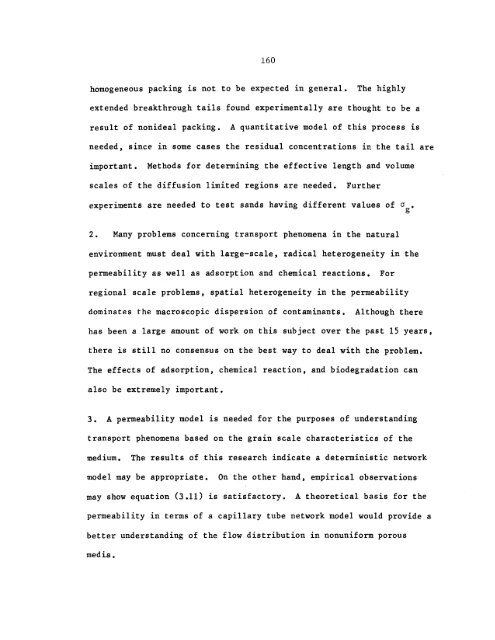longitudinal dispersion in nonuniform isotropic porous media
longitudinal dispersion in nonuniform isotropic porous media
longitudinal dispersion in nonuniform isotropic porous media
You also want an ePaper? Increase the reach of your titles
YUMPU automatically turns print PDFs into web optimized ePapers that Google loves.
160<br />
homogeneous pack<strong>in</strong>g is not to be expected <strong>in</strong> general. The highly<br />
extended breakthrough tails found experimentally are thought to be a<br />
result of nonideal pack<strong>in</strong>g. A quantitative model of this process is<br />
needed, s<strong>in</strong>ce <strong>in</strong> some cases the residual concentrations <strong>in</strong> the tail are<br />
important. Methods for determ<strong>in</strong><strong>in</strong>g the effective length and volume<br />
scales of the diffusion limited regions are needed. Further<br />
experiments are needed to test sands hav<strong>in</strong>g different values of cr •<br />
g<br />
2. Many problems concern<strong>in</strong>g transport phenomena <strong>in</strong> the natural<br />
environment must deal with large-scale, radical heterogeneity <strong>in</strong> the<br />
permeability as well as adsorption and chemical reactions. For<br />
regional scale problems, spatial heterogeneity <strong>in</strong> the permeability<br />
dom<strong>in</strong>ates the macroscopic <strong>dispersion</strong> of contam<strong>in</strong>ants. Although there<br />
has been a large amount of work on this subject over the past 15 years,<br />
there is still no consensus on the best way to deal with the problem.<br />
The effects of adsorption, chemical reaction, and biodegradation can<br />
also be extremely important.<br />
3. A permeability model is needed for the purposes of understand<strong>in</strong>g<br />
transport phenomena based on the gra<strong>in</strong> scale characteristics of the<br />
medium. The results of this research <strong>in</strong>dicate a determ<strong>in</strong>istic network<br />
model may be appropriate. On the other hand, empirical observations<br />
may show equation (3.11) is satisfactory. A theoretical basis for the<br />
permeability <strong>in</strong> terms of a capillary tube network model would provide a<br />
better understand<strong>in</strong>g of the flow distribution <strong>in</strong> <strong>nonuniform</strong> <strong>porous</strong><br />
<strong>media</strong>.

















